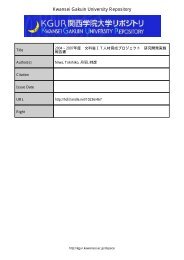Kwansei Gakuin University Repository
Kwansei Gakuin University Repository
Kwansei Gakuin University Repository
Create successful ePaper yourself
Turn your PDF publications into a flip-book with our unique Google optimized e-Paper software.
cational background as a determinant of exit of new firms. As already discussed,<br />
some studies emphasize that entrepreneurs’ human capital plays an important role<br />
in firm survival. Bates (1990) found that entrepreneurs’ human capital inputs affect<br />
small business longevity, and Cressy (1996) argued that human capital is the true<br />
determinant of firm survival. The effect of educational background may also vary<br />
between the different forms of exit. It is particularly expected that while firms with<br />
highly educated entrepreneurs are less likely to go bankrupt, large firms may tend to<br />
disappear by merger because of their superior resources. On the other hand, it is of-<br />
ten argued that because highly educated people tend to have alternative employment<br />
opportunities and receive a large number of job offers, they are more likely to move<br />
to alternative employment (e.g., Gimeno et al. 1997; Taylor, 1999). The variable for<br />
educational background is defined as a dummy variable indicating the value of one if<br />
the entrepreneur has a university education (EDU_UNIV ). However, because the<br />
entrepreneur’s educational background is unknown for some observations in our data<br />
set, a dummy variable for those firms (EDU_X) is also included in the model. The<br />
effect of the entrepreneur’s age when the entrepreneur started the business is exam-<br />
ined in the model. When some entrepreneurs are approaching retirement age and<br />
cannot find a successor, they may be more likely to close their companies voluntarily.<br />
In our analysis, we use several dummy variables for age classes: less than 30 years<br />
old (reference), 30–39 years old (AGE_30-39), 40–49 years old (AGE_40-49), 50–59<br />
years old (AGE_50-59), 60 years old and more (AGE_60). If the entrepreneur’s age<br />
is unknown, a dummy variable (AGE_X) is used.<br />
Using these independent variables, we explore the determinants of exit of new<br />
firms according to forms of exit—bankruptcy, voluntary liquidation, and merger.<br />
18
















